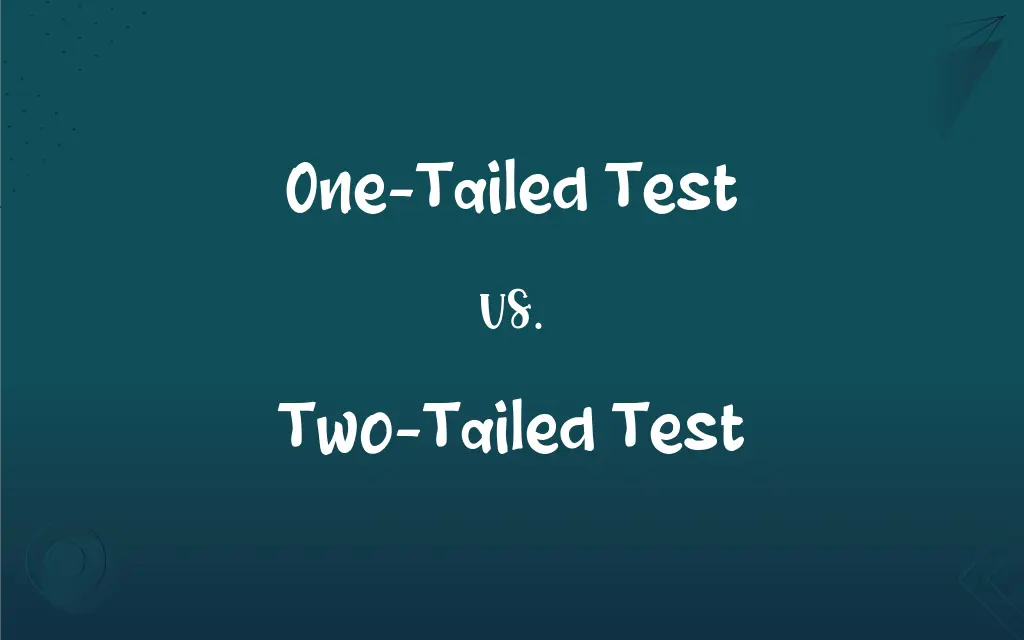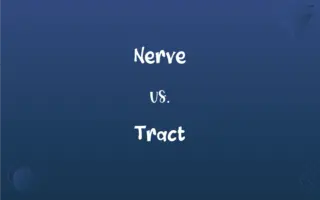One-Tailed Test vs. Two-Tailed Test: What's the Difference?
Edited by Aimie Carlson || By Harlon Moss || Published on March 14, 2024
A one-tailed test assesses the direction of an effect (greater or less than), while a two-tailed test evaluates the existence of any effect, regardless of direction.

Key Differences
A one-tailed test is used when a researcher has a specific hypothesis about the direction of an effect or relationship. A two-tailed test, conversely, is appropriate when the researcher does not have a directional hypothesis and is open to finding an effect in either direction.
In a one-tailed test, the significance is checked in one direction of the distribution, either greater than or less than a certain value. In a two-tailed test, the significance is evaluated on both ends of the distribution, accounting for both possible directions of the effect.
One-tailed tests are often more powerful than two-tailed tests for detecting an effect in a specified direction because they focus the statistical testing power in one tail of the distribution. However, two-tailed tests are more conservative and are used when the direction of the effect is not predetermined.
Researchers use a one-tailed test when they hypothesize that a parameter will either increase or decrease, but not both. A two-tailed test is chosen when the hypothesis admits the possibility of an effect in either direction, making it a safer choice when the direction of the effect is uncertain.
The choice between a one-tailed and a two-tailed test affects the interpretation of statistical significance. In a one-tailed test, a significant result supports the hypothesis in one specific direction, while in a two-tailed test, it indicates a significant effect but does not specify the direction.
ADVERTISEMENT
Comparison Chart
Direction of Effect
Tests for effect in one specified direction
Tests for effect in either direction
Significance Evaluation
In one end (tail) of the distribution
In both ends (tails) of the distribution
Hypothesis Specificity
Requires a specific directional hypothesis
Does not require a directional hypothesis
Statistical Power
More power to detect effect in one direction
Evenly distributes power in both directions
Suitability
Used when the direction of the effect is known or hypothesized
Used when direction of effect is unknown or could be either
ADVERTISEMENT
One-Tailed Test and Two-Tailed Test Definitions
One-Tailed Test
Assumes the null hypothesis is false in one direction.
Using a one-tailed test, researchers found an increase in customer satisfaction after service improvements.
Two-Tailed Test
Does not require a specific directional hypothesis.
The two-tailed test was appropriate to see if there was any difference in effectiveness between the two drugs.
One-Tailed Test
Tests a hypothesis in a specific direction.
A one-tailed test was used to determine if the new drug significantly lowers blood pressure.
Two-Tailed Test
Tests both ends of the probability distribution.
A two-tailed test showed significant change in reaction times, but did not specify the direction of change.
One-Tailed Test
Focuses on one end of the probability distribution.
The one-tailed test showed significant increase in sales after the marketing campaign.
Two-Tailed Test
Equally sensitive to effects in both directions.
Using a two-tailed test, researchers found significant changes in patient outcomes, both improvements and declines.
One-Tailed Test
More powerful in detecting effects in a specified direction.
The one-tailed test revealed a significant decrease in cholesterol levels due to the diet.
Two-Tailed Test
Suitable when unsure of the effect direction.
A two-tailed test was chosen to investigate whether changing the diet influences body weight, regardless of whether it increases or decreases.
One-Tailed Test
Suitable for hypotheses predicting an increase or decrease.
A one-tailed test was conducted to check if employee training reduced the error rate.
Two-Tailed Test
Assesses the possibility of an effect in either direction.
The two-tailed test was used to evaluate if the new teaching method had any effect on test scores.
FAQs
What is a two-tailed test?
A statistical test that evaluates the existence of an effect in either direction, without specifying the direction.
What is the advantage of a two-tailed test?
It's more conservative, allowing for the detection of effects in either direction.
Does a one-tailed test have more statistical power?
Yes, in the specified direction, because it concentrates the statistical significance in one tail.
What is a one-tailed test?
It's a statistical test that assesses the direction of an effect or relationship in one specific direction.
When is a one-tailed test used?
When the researcher has a specific hypothesis about the direction of an effect, such as expecting an increase or decrease.
Can a one-tailed test detect effects in both directions?
No, it only tests for an effect in one predetermined direction.
Is a two-tailed test more suitable when the direction of effect is unknown?
Yes, because it assesses both possible directions of the effect.
Can the choice of test affect research outcomes?
Yes, choosing the wrong test type can lead to incorrect conclusions about the data.
How does hypothesis specificity differ between these tests?
A one-tailed test requires a specific directional hypothesis, while a two-tailed test does not.
How does the interpretation of results differ between these tests?
In a one-tailed test, results are interpreted in the context of the specified direction, while in a two-tailed test, the direction is not specified.
Can a two-tailed test be used to confirm a one-tailed hypothesis?
Yes, but it's less powerful for that specific hypothesis direction.
How does sample size affect these tests?
Larger sample sizes generally provide more reliable results for both test types.
What if the actual effect is in the opposite direction in a one-tailed test?
The one-tailed test would fail to detect this, as it only looks in one direction.
Can you switch from a two-tailed to a one-tailed test after seeing the data?
No, this is considered inappropriate as it can lead to biased results.
What is the null hypothesis in a one-tailed test?
It states that there is no effect or a lesser effect in the specified direction.
What does a significant result in a one-tailed test indicate?
It indicates a significant effect in the specified direction.
What is the null hypothesis in a two-tailed test?
It states that there is no effect in either direction.
Are one-tailed tests appropriate for exploratory research?
Typically no, because they require a specific direction for the hypothesis.
Are one-tailed tests less common than two-tailed tests?
Yes, because they require a strong justification for the directional hypothesis.
How do you decide which test to use?
The decision is based on the research question and hypothesis specificity.
About Author
Written by
Harlon MossHarlon is a seasoned quality moderator and accomplished content writer for Difference Wiki. An alumnus of the prestigious University of California, he earned his degree in Computer Science. Leveraging his academic background, Harlon brings a meticulous and informed perspective to his work, ensuring content accuracy and excellence.
Edited by
Aimie CarlsonAimie Carlson, holding a master's degree in English literature, is a fervent English language enthusiast. She lends her writing talents to Difference Wiki, a prominent website that specializes in comparisons, offering readers insightful analyses that both captivate and inform.































































